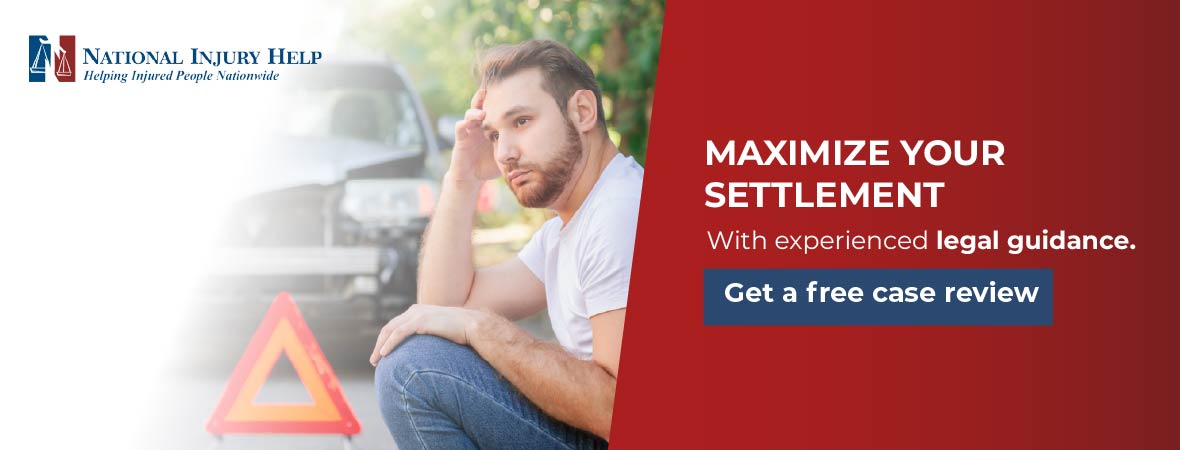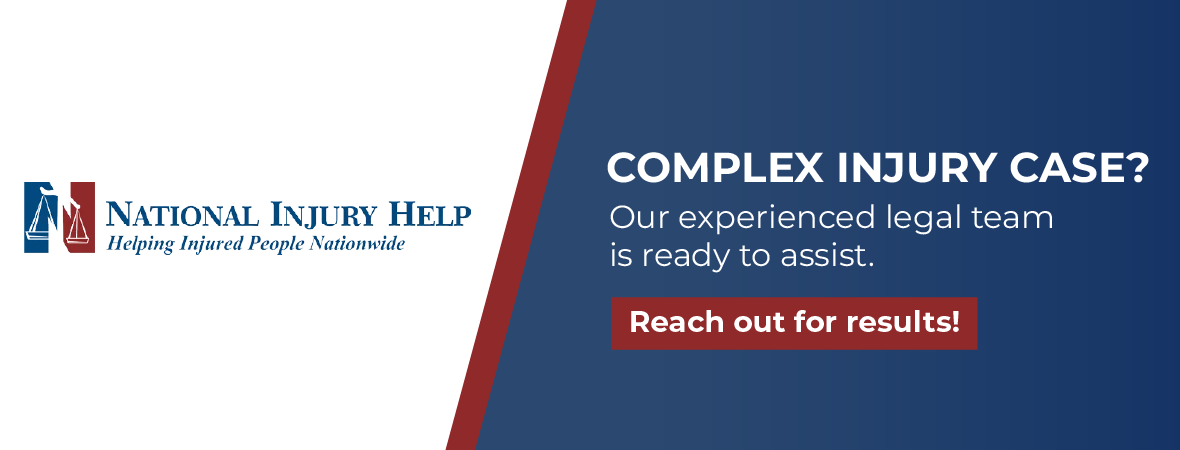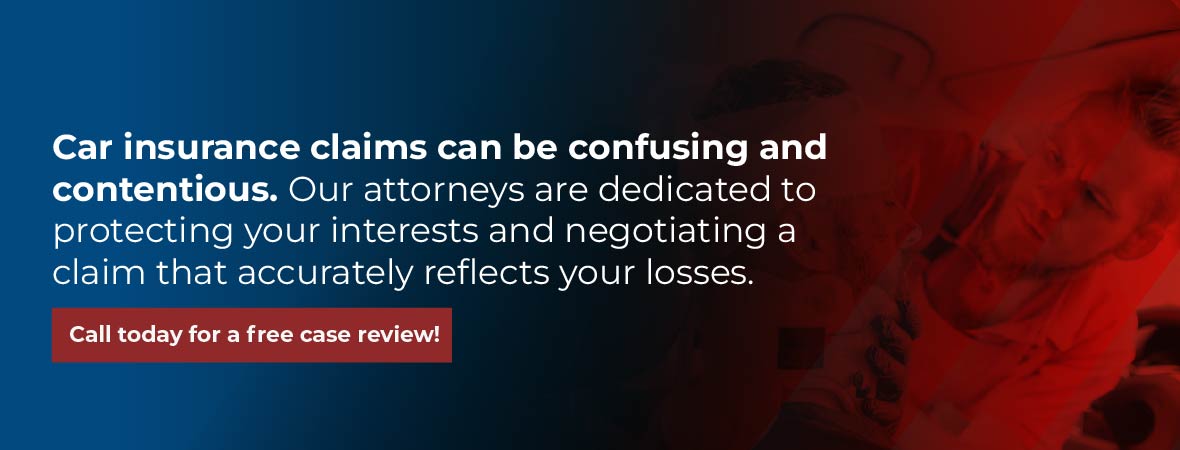Dealing with car insurance after an accident can be overwhelming. Learn how to avoid common pitfalls and get the full compensation you are owed. National Injury Help can step in and handle the process for you. Call 1 (800) 214-1010 today.
A car accident, no matter how minor, can throw your whole life off track. One minute you’re headed to work or running errands, and the next you’re pulled over on the side of the road, your hands shaking, glass on the ground, and your head spinning with questions like: How bad is the damage? Will insurance cover my medical bills? How can I deal with my insurance company?
It’s a lot to deal with, especially when you’re still trying to process what just happened. But knowing what to do ahead of time can make all the difference. Understanding the steps of the insurance claim process helps you protect your rights, avoid common mistakes, and increase your chances of getting a fair payout.
While each state has its own set of insurance laws, most of the process looks similar across the country. Whether you’re in a “fault” state or a “no-fault” state, the basics are safety first, document everything, report the accident, follow through, and apply everywhere. What can change are the deadlines, the paperwork requirements, and who ends up paying for what.
No matter where you live or how serious the crash was, having a clear roadmap helps take the stress out of an already difficult situation. With the right information, you can move forward with more confidence and focus on getting your life back on track.
Immediate Steps After a Car Accident
Here are some of the steps you should take immediately after a car crash.
A. Put Safety First and Get Medical Help
Your top priority is safety, yours, your passengers’, and that of everyone else on the road. If the cars can be driven and it is safe to do so, move them out of traffic to prevent a second crash. Turn on hazard lights before stepping out, and set out roadside triangles or flares if you have them.
Check yourself for bleeding, dizziness, or sharp pain, then check each passenger. Ask direct questions like “Can you wiggle your toes?” instead of simply asking “Are you okay?” Call 911 whenever someone is hurt, if vehicles are disabled, or if you feel unsafe. Paramedics can spot concussions, internal bleeding, or whiplash, injuries that might not show up until the adrenaline fades.
Tip: Even a “minor” collision can cause hidden injuries. When in doubt, let a medical professional make the call. Medical records from the same day of the crash also strengthen your claim.
B. Notify the Police and Create an Official Record
Nearly every state requires drivers to report a crash that causes injury, death, or a specific amount of property damage (often as low as $1,000). Because modern bumpers alone can exceed that threshold, it is almost always smart to call law enforcement. An officer will:
- Secure the scene and direct traffic
- Summon tow trucks if needed
- Gather statements from drivers and witnesses
- File an official crash report (sometimes called an incident or accident report)
That report becomes crucial evidence when insurance companies debate fault.
C. Exchange Essential Information
Once everyone is safe and first responders say it is okay to talk, exchange the following details:
- Full names and best phone numbers of all drivers
- Current addresses listed on each driver’s license
- Driver’s license numbers and issuing states
- License plate numbers and registration states
- Insurance companies, policy numbers, and customer-service phone lines
Stay calm and polite. Avoid blaming anyone, including yourself. Simple statements like “Let’s share our info so the insurers can sort things out” keep the conversation short and cordial. Gather passenger and eyewitness contact details as well; neutral witnesses can tip the scales when stories conflict.
D. Document the Scene Thoroughly
Your smartphone is your best friend. Before tow trucks arrive or vehicles are moved:
- Take wide shots showing where the cars came to rest relative to lane lines, intersections, or traffic signs.
- Capture close-ups of dents, busted headlights, deployed airbags, and skid marks.
- Photograph weather conditions such as rain, snow, glaring sun, or fog.
- Record any visible injuries (for example, swelling on your wrist or a bleeding cut).
- Use the phone’s voice memo or notes app to dictate a time-stamped summary while details are fresh: your speed, traffic light color, lane position, and what you remember feeling or hearing.
Memories fade rapidly once shock subsides. Early notes help you stay consistent if questioned weeks later.
How Car Insurance Works Across the United States
Because insurance rules differ by state, you need to know which system applies where you live or where the crash occurred. Below are the two main models and some universal concepts:
A. Minimum Liability Requirements
Every state sets minimum liability limits, which are the smallest amount of coverage a driver must carry to legally register and operate a car. Common minimums include:
- $25,000 for bodily injury per person
- $50,000 for bodily injury per accident
- $25,000 for property damage
Some states require higher (or lower) amounts, and a handful mandate personal injury protection (PIP) or uninsured/underinsured motorist (UM/UIM) coverage. Buying more than the minimum is usually wise; medical bills and modern vehicle repairs can skyrocket well past base limits.
B. Fault vs. No-Fault States
- Fault (Tort) States: In most of the country, the at-fault driver (or that driver’s insurer) pays for injuries, lost wages, and repairs. If the responsible driver’s policy is insufficient, the injured person can sue for the remainder.
- No-Fault States: About a dozen states, including Florida, Michigan, and New York, use no-fault or PIP systems. After a crash, each driver’s own policy pays medical expenses up to a specified limit, regardless of who caused the wreck. Lawsuits are restricted to severe cases (serious injury thresholds vary by state).
Key takeaway: Learn your state’s system. If you travel often, keep in mind that claims are typically governed by the state where the crash happens, not by the state on your license plate.
C. Comparative and Contributory Negligence
Most U.S. states apply some version of comparative negligence: your payout is reduced by your percentage of fault. For example, if you are 20% at fault in a $10,000 case, you collect $8,000. A few states, like North Carolina and Virginia, use a stricter “contributory negligence” rule; if you are even 1% at fault, you may recover nothing. Collecting solid evidence (photos, witness statements, dash-cam video) can protect your share.
Filing a Car Insurance Claim Step-by-Step
A. Report the Crash Promptly
Most policies require “prompt notice,” often defined as 24–72 hours. Regardless of fault, call your own insurer quickly. Provide basic facts:
- Date, time, and place of the crash
- Names of drivers and passengers
- Police report number (if known)
Ask if you should also open a claim under collision, PIP, medical payments (MedPay), rental reimbursement, or UM/UIM coverage. Your representative will give you a claim number and explain the next steps.
B. Gather and Organize Documentation
Build a digital or paper folder containing:
- The official police report
- Photos and video from the scene
- Contact information and statements from witnesses
- Medical records: emergency-room notes, doctor visits, prescriptions, physical-therapy logs
- Repair estimates (get more than one if required)
- Receipts for towing, rental cars, and out-of-pocket expenses
- Proof of lost wages (pay stubs, employer letters)
Keep a claim diary listing every phone call or email: date, time, the person you spoke with, and a short summary of what was discussed. Organization today prevents headaches tomorrow.
C. Dealing with Insurance Adjusters
Insurance adjusters investigate claims and decide payouts. Be truthful, yet brief. Stick to facts you witnessed. If you do not remember something, say so. Guessing can create inconsistencies that the insurer might use to reduce your compensation.
Do not sign a broad medical release giving access to your entire medical history. Share only records related to accident injuries unless your attorney advises otherwise.
D. Evaluate Settlement Offers Carefully
A quick check can feel like relief, but once you sign a release, your claim generally closes forever, even if new symptoms surface. Serious whiplash, concussions, or back injuries often appear days or weeks later. Discuss any offer with a doctor and, for sizable claims, with a lawyer. Make sure it covers:
- Current and future medical treatment
- Lost income and diminished earning capacity
- Repair or replacement of your vehicle
- Pain and suffering (called “general damages”)
Common Roadblocks (and How to Get Around Them)
Below, we provide a list of some of the challenges you might encounter when navigating your car accident case.
A. Disputed Fault
If the other driver denies responsibility, you may need extra evidence such as:
- Traffic-camera or surveillance footage
- Dash-cam video (yours or a witness’s)
- Event Data Recorder (EDR or “black box”) downloads that show speed and brake use.
- Expert accident-reconstruction reports
An attorney can subpoena data you cannot access on your own.
B. Lowball Offers
Insurers are businesses; paying less boosts their profits. Counter unfair offers with a detailed demand package: a spreadsheet of every expense, receipts, medical opinions, and a concise letter explaining your figure. Follow up politely but firmly. If negotiations stall, remind the adjuster that juries often award more when evidence is strong.
C. Delays and Lack of Communication
Most states require insurers to acknowledge a claim within 10–15 business days and accept or deny it within a “reasonable” period (often 30–45 days after receiving proof of loss). Keep notes of unanswered calls or emails. If delays exceed local regulations, file a complaint with your state’s department of insurance. The prospect of regulatory scrutiny usually speeds things up.
When to Call a Car Accident Lawyer
- Severe Injuries or High Dollar Amounts: Fractures, spinal damage, or traumatic brain injuries can require lifelong care. A lawyer calculates future costs and negotiates aggressively.
- Disputed Liability or Multi-Vehicle Pileups: Three-car crashes often involve several insurers blaming each other. Attorneys untangle percentages of fault and push each company to pay its share.
- Bad-Faith Insurance Practices: If an insurer denies, delays, or undervalues a legitimate claim without cause, you may sue for bad faith, which can result in extra (punitive) damages.
Most personal injury attorneys offer free consultations and work on contingency: no fee unless they win money for you. This levels the playing field against large insurance carriers.
Extra Tips for a Smooth Car Insurance Claim Process
These are some additional tips to help your case.
- Stay Organized. Use a spreadsheet or notebook to log every contact, cost, and promise.
- Follow Up Promptly. If an adjuster says, “I’ll get back to you Friday,” call Monday if you have not heard anything.
- Stay Calm but Assertive. Polite persistence works better than anger.
- Limit Social Media. Posts showing you lifting groceries or enjoying a weekend hike can be twisted into “proof” you are not hurt. Keep accounts private and avoid talking about the crash online.
- Know Your Coverage Before an Accident. Review your policy once a year. Consider adding UM/UIM and higher liability limits. These are cheaper than you might think and can save you thousands.
Contact a Car Accident Lawyer
If mounting medical bills, car-rental fees, and unreturned calls from the insurance company leave you overwhelmed, reach out to National Injury Help by calling 1 (800) 214-1010 today.
We will listen, review your paperwork for free, and explain what your claim should be worth. We negotiate aggressively, file lawsuits when fairness demands it, and charge no attorney fees unless we secure compensation for you.









